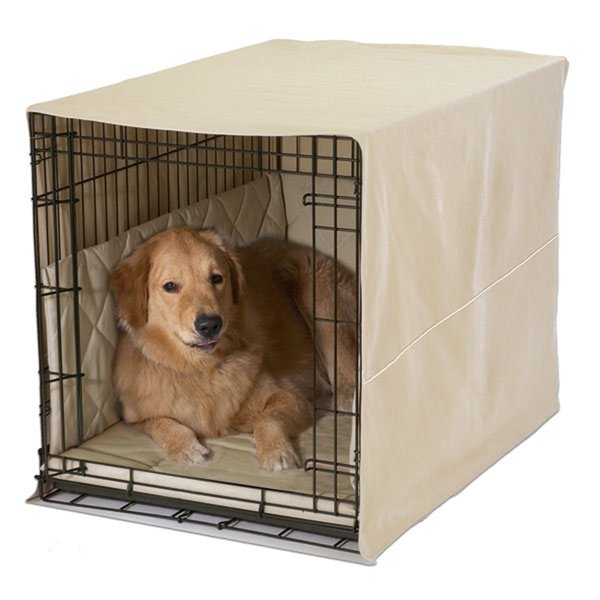Your new puppydog needs lots of attention
(companionship, education, and play), but also to be
taught how to entertain himself appropriately and how to
thoroughly enjoy his time when left at home alone.
Otherwise, a social vacuum can be a very lonely place.
Puppies and dogs predictably develop housesoiling,
chewing, digging, and barking problems if allowed too
much freedom and too little supervision and guidance
during their first few weeks at home. Puppies and newly
adopted dogs may become overdependent if allowed
unrestricted access to their owners during the initial time
in their new home. Overdependent dogs often become
anxious when left at home alone, and they attempt to
adapt to the boredom and stress of solitary confinement
by busying themselves with doggy activities—chewing,
digging, barking—which soon become owner-absent
behavior problems. What else is there to do? Severely
stressed dogs may work themselves up into a frenzy and
spend the day circling, pacing, and panting.
A Special Place
Dogs are den animals, and they value their own special place — a place for peaceful retreat, a methodical chew, or even a snooze. A doggy den (a collapsible and portable dog crate and dog bed) is an ideal training tool. Apart from its obvious uses for transporting dogs by car, train or plane, a crate may be used for short-term confinement when you cannot supervise your puppy—to keep him out of mischief and prevent him from making housesoiling, destructive chewing, and digging mistakes. In addition, the crate may be used specifically to create good household habits: to housetrain your puppy; to establish a hard-to-break chewtoy habit; to reduce excessive barking; to prevent inappropriate digging; and to foster confidence and calmness.
Right from the outset, when you are home, regularly confine your pup for "little quiet moments"
in his dog crate in order to teach household manners and imbue confidence. Then your dog can
look forward to enjoying a lifetime with the full run of your house, whether you are home or not.
Teach Your Puppy to Enjoy His Doggy Den
A dog crate is really no different than a child's crib, playpen, or bedroom. The first item on the agenda is to teach your puppy to thoroughly enjoy spending time in his doggy den. Stuff your puppy's first meal into a hollow chew-toy, tie the chewtoy inside the crate, and leave the door open so the pup may come and go as he pleases. Praise your puppy while he chews the chewtoy and supervise the puppy if he leaves the crate. Once the pup has settled down for a quiet chew, you may close the crate door. For your pup's second meal, put the stuffed chewtoys inside the crate and shut the door with the puppy on the outside. Once your puppy worries at the crate to get to his dinner, let the puppy enter his crate and close the door behind him. From now on, always give your puppy a stuffed chewtoy when confining him to his crate.
A dog crate is really no different than a child's crib, playpen, or bedroom. The first item on the agenda is to teach your puppy to thoroughly enjoy spending time in his doggy den. Stuff your puppy's first meal into a hollow chew-toy, tie the chewtoy inside the crate, and leave the door open so the pup may come and go as he pleases. Praise your puppy while he chews the chewtoy and supervise the puppy if he leaves the crate. Once the pup has settled down for a quiet chew, you may close the crate door. For your pup's second meal, put the stuffed chewtoys inside the crate and shut the door with the puppy on the outside. Once your puppy worries at the crate to get to his dinner, let the puppy enter his crate and close the door behind him. From now on, always give your puppy a stuffed chewtoy when confining him to his crate.
Teach Your Dog to Teach Herself
When at home, always confine your puppydog with a variety of hollow chewtoys stuffed with kibble and treats. Confining a dog to a crate with an attractive chewtoy is like confining a child to an empty room with a video game. This is called autoshaping. All you have to do is set up the situation, and your dog will automatically train herself. Each treat extricated from the chewtoy progressively reinforces chewing chewtoys and settling down calmly and quietly. Your dog will soon become hooked on her chewtoy-habit, leaving very little time for inappropriate chewing, digging, or barking. And if your puppydog is happily preoccupied chewing her chewtoy, she will fret less.
When at home, always confine your puppydog with a variety of hollow chewtoys stuffed with kibble and treats. Confining a dog to a crate with an attractive chewtoy is like confining a child to an empty room with a video game. This is called autoshaping. All you have to do is set up the situation, and your dog will automatically train herself. Each treat extricated from the chewtoy progressively reinforces chewing chewtoys and settling down calmly and quietly. Your dog will soon become hooked on her chewtoy-habit, leaving very little time for inappropriate chewing, digging, or barking. And if your puppydog is happily preoccupied chewing her chewtoy, she will fret less.
Your pup will soon learn that confinement is for a short time—and an enjoyable time.
Home-Alone Dogs
Need An Occupation
Preparing dogs for inevitable periods of solitary
confinement—and specifically teaching them
how to occupy their time when left at home alone—is the most pressing humane consideration for
any new puppy in any household. Every dog requires some form of enjoyable occupational
therapy. Vocational chewtoy chewing is the easiest and most enjoyable solution.
Dogs are crepuscular (most active at dawn and dusk), and so it is pretty easy to teach them how to calmly pass the time of day. During your puppydog's first few days and weeks at home, regularly confine him to a crate with stuffed chewtoys. Prepare the pup for your absence when you are present. When at home, it is possible to monitor your pup's behavior when confined for numerous short periods throughout the day. Your puppy's first impressions of an established daily routine create an acceptable and enjoyable status quo for years to come. Remember, once your puppy is confident, independent, and trained, he may enjoy free range of your house and garden for the rest of his life.

To learn more, read Doctor Dunbar's Good Little Dog Book and our Home Alone booklet, available on-line from www.amazon.com. Reprinted by www.dogstardaily.com with permission of Dr. Ian Dunbar and James & Kenneth Publishers, behavior blueprint by Dr. Ian Dunbar
Dogs are crepuscular (most active at dawn and dusk), and so it is pretty easy to teach them how to calmly pass the time of day. During your puppydog's first few days and weeks at home, regularly confine him to a crate with stuffed chewtoys. Prepare the pup for your absence when you are present. When at home, it is possible to monitor your pup's behavior when confined for numerous short periods throughout the day. Your puppy's first impressions of an established daily routine create an acceptable and enjoyable status quo for years to come. Remember, once your puppy is confident, independent, and trained, he may enjoy free range of your house and garden for the rest of his life.

To learn more, read Doctor Dunbar's Good Little Dog Book and our Home Alone booklet, available on-line from www.amazon.com. Reprinted by www.dogstardaily.com with permission of Dr. Ian Dunbar and James & Kenneth Publishers, behavior blueprint by Dr. Ian Dunbar




No comments:
Post a Comment